ZOO (Day 10 - part 4)


Zebras and antelopes happily share the same enclosure.
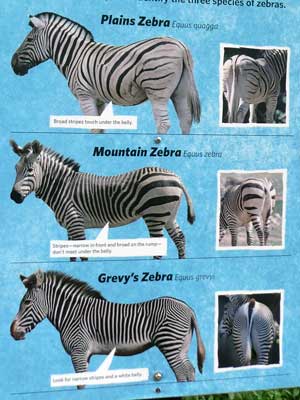

Ah, that's pretty easy! Grevy's zebra (or the imperial zebra) is the largest of the three zebra species. It's found in semi-arid savannas in Kenya and Ethiopia.

Eland are African antelopes. Both males and females have horns. They prefer fruits, seedpods, flowers, leaves and bark, sometimes even using their horns to break off branches. Horns can also be used for digging up melons, bulbs, roots and onions.


Bubbles?? Apparently a child was walking past with a bubble-blowing toy.
Eagle Canyon was home to some powerful birds of prey.




Looking down from the high walkway onto the flamingos

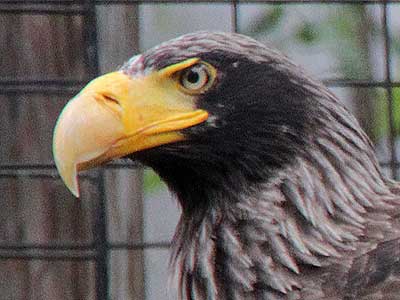
The Steller's sea-eagle lives along the coast of northeastern Russia where they seize salmon from icy waters. They build massive nests that can weigh over 400 pounds.


The Andean condor is a New World vulture found in the Andes mountains of South America. It has a wingspan of up to 10 and can weigh over 30 pounds. The California Condor has a longer body size but the Andean Condor is heavier. It is one of the world's longest-living birds, with a lifespan of over 70 years.


The head and neck are a dull red color which may flush and change color depending on the bird's emotional state.


The harpy eagle from Central America hunts large animals such as sloths, monkeys, iguanas, parrots and even domestic sheep. It hits its prey with strong force and speed, then grasps the animal with talons the size of grizzly bear claws.


The red panda (or lesser panda) is native to the Himalayas and China. It is related to raccoons and weasels and feeds mainly on bamboo. Kola is on constant walking patrol of his habitat; Adira often curls up at the top of her tree, and Clark seems to be a bit of a joker.



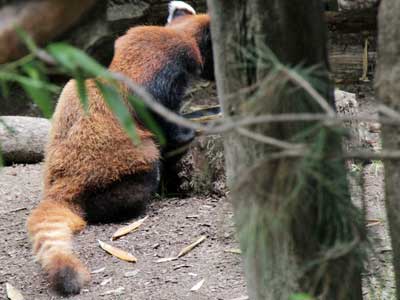


The takin is sometimes referred to as a goat antelope, because it is most closely related to sheep. Their skin secretes an oily substance that acts as a natural raincoat.


Their large nose has big sinus cavities. This allows inhaled air to warm up before it gets to the lungs. Without this, they'd lose a large amount of body heat simply by breathing in the cold winters in the Himalayan Mountains.


The Mang Mountain pit viper had a massive exhibit! Even though it gets up to 7 feet long, it's pretty elusive and rarely seen. But we found it!
Elephant Odyssey opened in 2009. It includes a live elephant exhibit as well the Fossil Portal which gives a glimpse into the past of the ancient animals that once roamed Southern California.





Ice age short-faced bears were almost 5 feet tall just walking around, and could stand to 11 feet. They dwarfed today's grizzly bears!

Mammoths, saber-toothed cats, American lions, Daggett's eagles, dire wolves, short-faced bears and ground sloths mingled with
animals of today such as bison, black bears, condors, bobcats, flamingos, coyotes, mountain lions and pronghorn
as well as those who moved elsewhere such as jaguars, tapirs, capybaras, camels and cheetahs.
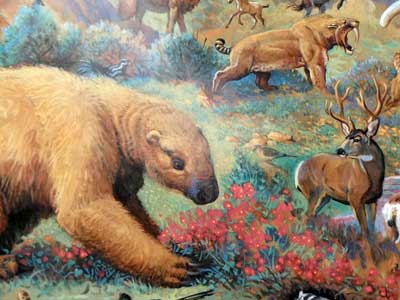


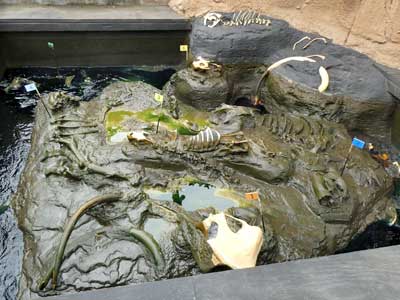
An artificial tar pit with (man-made) Pleistocene-era bones


Elephant Odyssey ... The North American lion (or American cave lion) lived in North America some 340,000 to 12,800 years ago. It was about 25% larger than the modern lion.


Camels originated in North America then migrated to Asia and Africa. 12,000 years ago, herds of them wandered about here. ... Merriam's teratorn weighed over 30 pounds and a wingspan up to 12 feet. It probably stalked its prey on the ground, swallowing it whole.

The pronghorn is the fastest land mammal in North America, with speeds up to 60 mph. It is second fastest in the world, losing only to the cheetah, which lives far, far away in Africa. So why does the pronghorn have to be so fast? What predator is it running from? Ironically, it is actually still running from the cheetah!
The American cheetah lived here during the Pleistocene epoch (2.6 million – 12,000 years ago) ... the same time as the pronghorn. Eventually many species (mammoths, camels, horses, cheetahs, etc) went extinct on this continent. Fortunately some of them had already crossed the land bridge to Asia and continued to survive elsewhere. The horse, for example, was returned to its native American homelands by the Spaniards in the 1500's, but the cheetah has remained away... however, the pronghorn apparently refuse to believe that.


American cheetah ... pronghorn
return • continue

